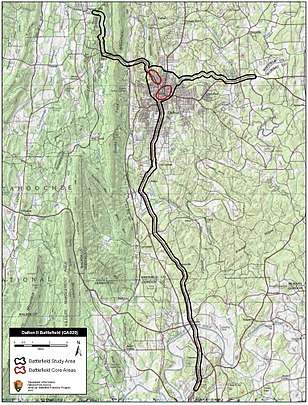Second Battle of Dalton
The Second Battle of Dalton was fought August 14–15, 1864, between Union and Confederate forces in Whitfield County northern Georgia.[2]
Battle

Confederate cavalry, commanded by Maj. Gen. Joseph Wheeler raided northern Georgia to disrupt William T. Sherman's supply lines and destroy the railroad track, hoping to force Sherman to retreat from the state. On August 14, Wheeler demanded the surrender of the Union garrison at Dalton, Georgia, commanded by Colonel Bernard Laiboldt. Laiboldt refused and held out inside his fortifications, though sporadic fighting continued until midnight.[2][3]
The next morning, Wheeler ended his attack and prepared to retreat. Union reinforements arrived from Chattanooga, commanded by Maj. Gen. James B. Steedman, and engaged Wheeler's cavalry.[2] Skirmishing continued for four hours, before the Confederates finally left the field.[2]
The amount of damage inflicted by Wheeler on the railroad is debatable.[2] However, Maj. Gen. George H. Thomas in Nashville reported that the track south of Dalton was quickly repaired and trains were running again within two days.[4]
Battlefield Condition
The growth of the City of Dalton has destroyed the battlefield landscape and its historic setting.[5]
References
- The war of the rebellion: a compilation of the official records of the Union and Confederate armies. ; Series 1 - Volume 38 (Part I). Cornell University Library. p. 162. Retrieved 14 August 2016.
- "Battle Summary". National Park Service. Retrieved 14 August 2016.
- Laibold, Colonel Bernard (1 September 1864). "The Attack Upon Dalton". St. Louis Democrat. Retrieved 14 August 2016.
- The war of the rebellion: a compilation of the official records of the Union and Confederate armies. ; Series 1 - Volume 38 (Part I). Cornell University Library. p. 163. Retrieved 14 August 2016.
- Civil War Sites Advisory Commission Report on the Nation's Civil War Battlefields (PDF). National Park Service. 1993. p. 46. Retrieved 15 August 2016.
External links
- National Park Service battle summary
- CWSAC Report Update and Resurvey: Individual Battlefield Profiles
- Laiboldt's Report as printed in the New York Times
- Lloyd's battle history of the great rebellion: Dalton, Georgia